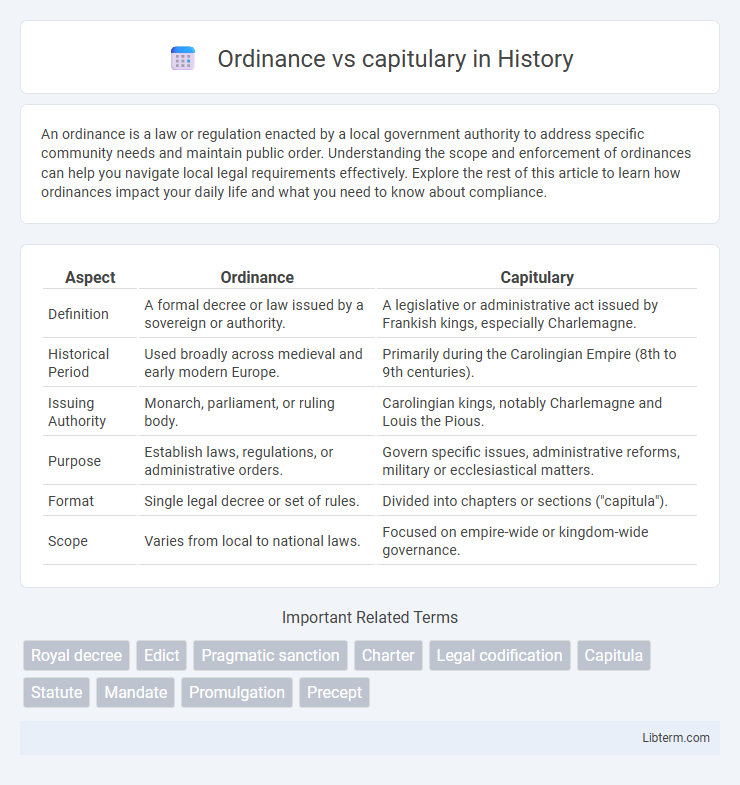An ordinance is a law or regulation enacted by a local government authority to address specific community needs and maintain public order. Understanding the scope and enforcement of ordinances can help you navigate local legal requirements effectively. Explore the rest of this article to learn how ordinances impact your daily life and what you need to know about compliance.
Table of Comparison
| Aspect | Ordinance | Capitulary |
|---|---|---|
| Definition | A formal decree or law issued by a sovereign or authority. | A legislative or administrative act issued by Frankish kings, especially Charlemagne. |
| Historical Period | Used broadly across medieval and early modern Europe. | Primarily during the Carolingian Empire (8th to 9th centuries). |
| Issuing Authority | Monarch, parliament, or ruling body. | Carolingian kings, notably Charlemagne and Louis the Pious. |
| Purpose | Establish laws, regulations, or administrative orders. | Govern specific issues, administrative reforms, military or ecclesiastical matters. |
| Format | Single legal decree or set of rules. | Divided into chapters or sections ("capitula"). |
| Scope | Varies from local to national laws. | Focused on empire-wide or kingdom-wide governance. |
Introduction to Ordinances and Capitularies
Ordinances and capitularies are essential legal instruments in medieval European governance, primarily used by monarchs to regulate administration and justice. Ordinances served as formal, public laws issued for permanent application, often addressing broad legal and administrative reforms. Capitularies, typically issued by Frankish rulers like Charlemagne, consisted of detailed, specific directives divided into chapters to guide officials on various administrative, military, and ecclesiastical matters.
Historical Context of Legal Documents
Ordinances and capitularies are key legal documents from medieval Europe, with ordinances typically issued by monarchs to regulate administrative or judicial matters in their realms. Capitularies, predominantly associated with the Carolingian dynasty, consist of royal decrees divided into chapters addressing various aspects of governance, law, and church relations during the early Middle Ages. Both documents reflect the evolving legal frameworks and centralization efforts in medieval governance, illustrating the development of state authority and legal codification.
Definition of Ordinance
An ordinance is a formal decree or authoritative order issued by a governing body, often outlining laws or regulations with binding legal force. Unlike capitularies, which were collections of royal decisions and administrative rules in the Carolingian Empire, ordinances serve as specific statutes enacted by municipal or governmental authorities. Ordinances typically address local governance issues and are essential for maintaining public order and regulatory compliance.
Definition of Capitularies
Capitularies are legislative or administrative orders issued by Frankish kings, especially Charlemagne, comprising chapters (capitula) addressing various legal or governance matters. These documents functioned as crucial tools for centralizing royal authority and standardizing laws across the Carolingian Empire. Unlike ordinances, capitularies were often detailed directives covering both civil and ecclesiastical issues within a structured chapter format.
Key Differences Between Ordinance and Capitulary
Ordinances are formal laws or decrees issued by a sovereign authority, often binding within a specific jurisdiction, whereas capitularies are collections of legislative or administrative orders issued by Frankish kings during the early medieval period. Ordinances typically address broader legal frameworks or public policies, while capitularies often contain detailed instructions on governance, military matters, or church affairs. The primary difference lies in their scope and historical context: ordinances function as general legal mandates, whereas capitularies serve as royal directives aimed at regional administration and enforcement.
Purpose and Function in Governance
Ordinances serve as local laws or regulations enacted by municipal authorities to manage community-specific issues, ensuring order and compliance within their jurisdiction. Capitularies, issued by Frankish kings like Charlemagne, functioned as royal decrees aimed at standardizing legal and administrative practices across broader territories to consolidate central authority. Both instruments played critical roles in governance by defining legal frameworks and facilitating the enforcement of policies at different administrative levels.
Examples of Famous Ordinances
Famous ordinances include the Ordinance of Villers-Cotterets (1539) issued by Francis I of France, which mandated the use of French in official documents and helped standardize the French language. Another notable example is the Ordinance of Nantes (1598) issued by Henry IV, granting limited religious freedoms to Protestants and promoting civil peace. Ordinances differ from capitularies, which were royal decrees primarily used by Frankish kings like Charlemagne to govern legal and administrative matters across the empire.
Notable Capitularies in History
Capitularies were royal legislative acts issued primarily by Frankish kings like Charlemagne, organizing governance and church reform through detailed chapters or "capitula." Notable capitularies include the "Capitulary of Herstal" (779), which strengthened administrative control and military obligations, and the "Capitulary of Villis" (circa 800), which regulated estate management and agricultural practices. Unlike ordinances, which are often local or municipal laws, capitularies played a significant role in shaping Carolingian law and Frankish statecraft.
Impact on Medieval Legal Systems
Ordinances and capitularies significantly shaped medieval legal systems by establishing royal authority and standardizing laws across realms. Ordinances, issued by monarchs, often addressed administrative and judicial reforms that reinforced centralized control and uniform legal practices. Capitularies, primarily issued by Carolingian rulers, organized diverse customary laws into systematic codes, facilitating governance and influencing the development of European legal traditions.
Contemporary Relevance and Legacy
Ordinances remain pivotal in modern legal frameworks, serving as tools for local governance and regulatory enforcement, reflecting their enduring legacy in administrative law. Capitularies, originating in the Carolingian era, provide historical insight into early legislative practices and continue to influence the development of European legal systems. Both forms exemplify foundational legal mechanisms, underscoring the evolution of rule-making from medieval to contemporary contexts.
Ordinance Infographic

 libterm.com
libterm.com